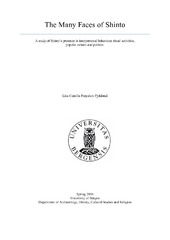The Many faces of Shinto. A study of Shinto’s presence in interpersonal behaviour, ritual activities, popular culture and politics
Master thesis
Permanent lenke
https://hdl.handle.net/1956/12344Utgivelsesdato
2016-05-16Metadata
Vis full innførselSammendrag
This thesis explores the many faces of Shinto and Shinto's role in Japan today. It looks at the aspects: Shinto as interpersonal behaviour, Shinto's presence in popular culture medium like manga, Shinto as ritual activities and Shinto in Japanese politics. Using material gathered from interviews, observations and the analysis of Adachitoka's manga Noragami: Stray God, these aspects and Shinto will be analysed. Furthermore the material will also be discussed using a theoretical approach and the theoretical perspectives of Hayao Miyazaki and Eva Hellman, who's socio-political definition of religion will be used to see whether Shinto can be defined as a religion. This thesis will try to emphasise the Japanese perspective of Shinto and how it is integrated in the Japanese society today. Denne oppgaven tar for seg shintoismen og dens mange ansikt i det japanske samfunn i dag. Shintoismen blir i vestlig tolkning oppfattet som religion, mens japanere selv mener shintoismen er en kulturarv. I Shintoismen så har man kami og tilbedelse av kami. Kami kan tolkes som en betegnelse for guder, men begrepet er diskutert i den akademiske verden. Jeg undersøker en rekke aspekter av shintoismen og relasjonene mellom dem. Aspektene er: shintoismen i mellommenneskelig adferd, shintoismens tilstedeværelse i populærkulturelle medier som manga, shintoisme som rituelle aktiviteter og shintoisme i japansk politikk. Jeg fokuserer på to former av shintoisme. Den ene er den formelle formen av shintoisme, den imperiale tilbedelsen (jingu). Den andre er den uformelle formen som er sett på som tilbedelse av kami (jinja). For a diskutere og analysere dette materialet bruker jeg to teoretiske perspektiver. Jeg bruker de teoretiske perspektivene til animasjons regissøren Hayao Miyazaki og religionsviteren Eva Hellman. Videre brukere jeg Hellman's sosio-politiske religionsdefinisjon for å undersøke om shintoismen kan regnes som en religion. Igjennom denne analysen prøver jeg å vise de mange aspektene av shintoismen og hvordan shintoismen er tilstede i Japan idag.
